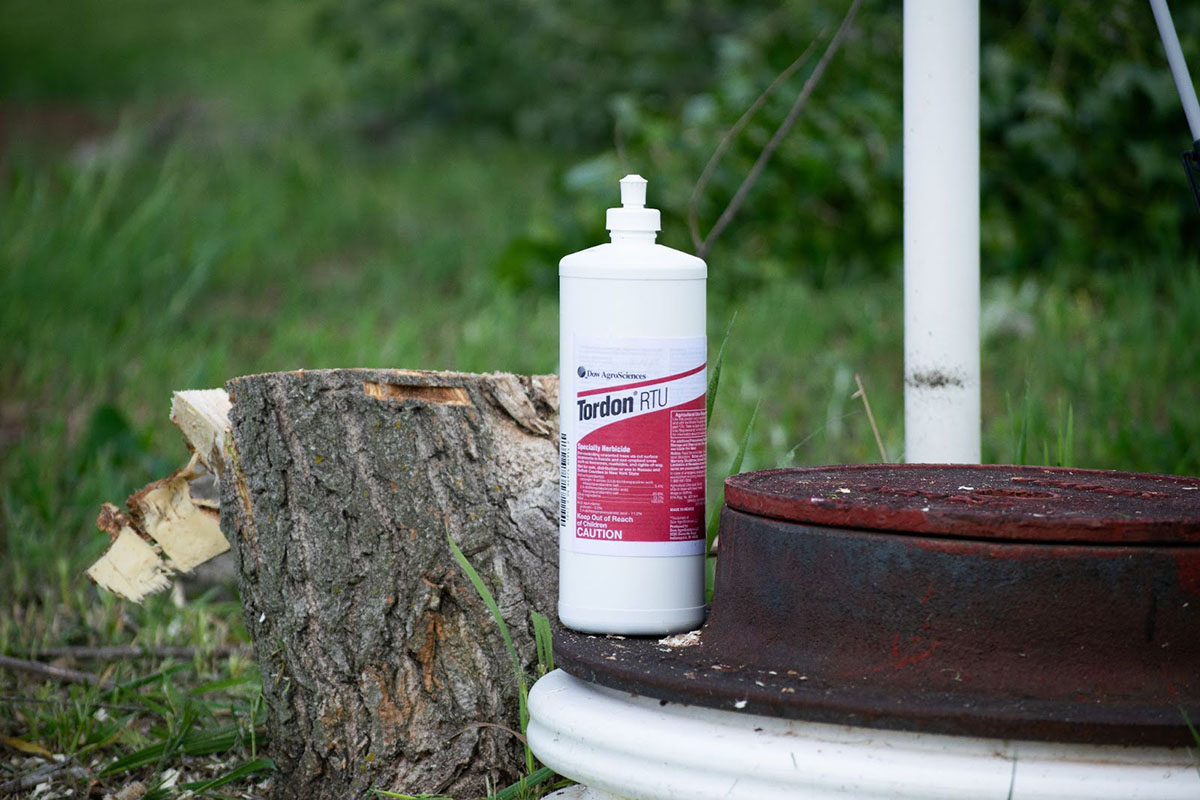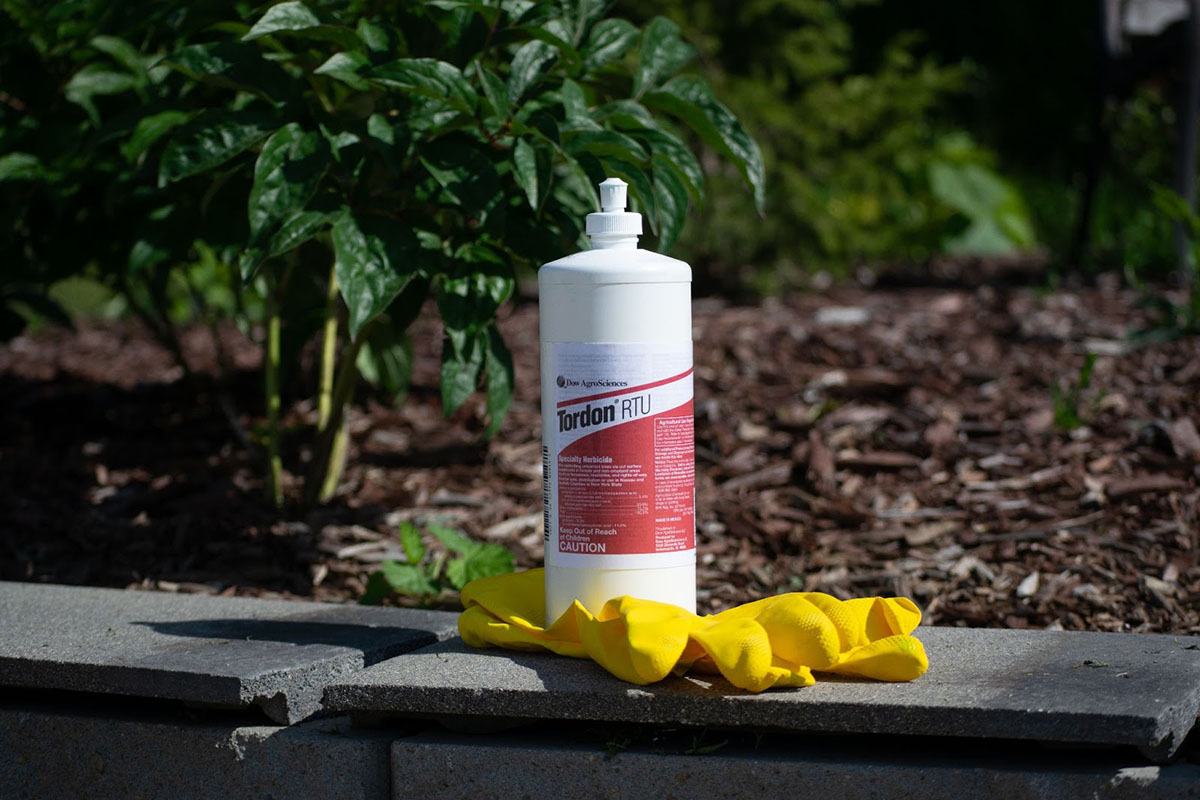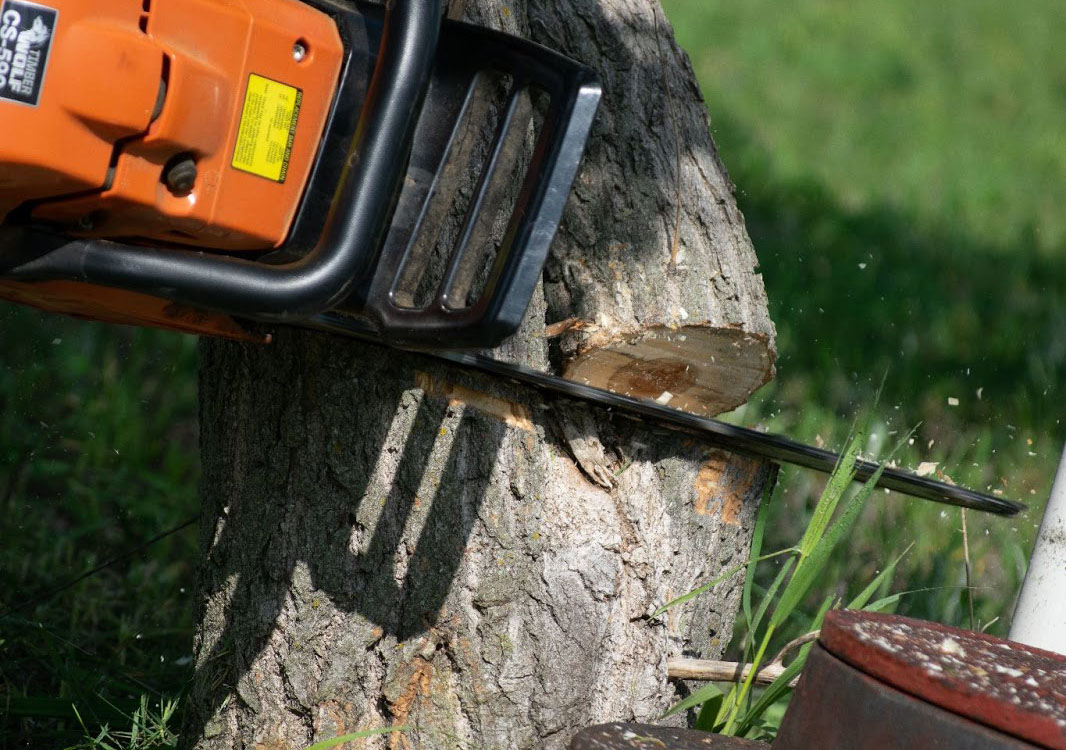

We may earn revenue from the products available on this page and participate in affiliate programs. Learn More ›
Living on a partially wooded 80-acre tract offers plenty of room to grow a variety of desirable trees, but it also provides ample opportunity for trees, shrubs, and woody vines to crop up where they’re not wanted. Such was the case with a cottonwood tree that sprouted near our rural water meter. The water company advised my husband and me to kill it before the roots could damage the water lines.
Having used glyphosate (the active ingredient in Roundup) to kill stumps in the past, only to have new tree shoots sprout from the trunk’s base a few months later, I was looking for something different. About a year ago, a local landscaper recommended Tordon herbicide (available from Amazon or Tractor Supply). Tordon contains picloram, a systemic herbicide that travels through the inner tree’s fibrous cells all the way to the roots, so the tree dies entirely and won’t send up new shoots. Ahead: See how easy it is to apply Tordon.
Verdict: For effectively eliminating invasive woody vines and hardy tree stumps, Tordon herbicide takes top honors.
Rating: 9.0/10

PROS
- Quickly kills freshly cut stumps
- Easy to apply
- No shoot regrowth
CONS
- Can kill nearby plants
- Requires careful application
- Not for use near water
Get the Dow AgroSciences Tordon RTU Herbicide at Amazon for $38.40 or at Tractor Supply for $21.99.
Scary Words, But Simple Specs
All commercial herbicides bear the words, “It is a violation of Federal law to use this product in a manner inconsistent with its labeling.” While I’ve never heard of anyone being charged with a crime for misuse, it’s crucial to take those words to heart. Tordon herbicide, like many chemical products, can be toxic if used incorrectly.
The Tordon bottle lists the ingredients, including picloram, and states that the product is designed to control unwanted trees in forests, roadways, and non-cropland areas. The tree we needed to cut down was in a remote spot at least a quarter of a mile from any home or roadway. The label also mentions to use Tordon in an undiluted form—it includes a screw-on lid, plus an additional pull-cap lid (similar to a dishwashing liquid bottle).
The label also states that Tordon is for use on freshly cut stumps—in other words, we needed to cut down the cottonwood tree and then treat the stump immediately afterward. Since we’ve been using Tordon for over a year now, we were familiar with the process and brought a chainsaw.

A Bright Squirt of Blue
Once we cut down the tree—the most difficult part of the whole process—applying Tordon was a breeze. We took the recommended precautions, wore gloves, and made sure the dogs didn’t follow us. Using a chainsaw comes with its own safety issues, so if you’re using one—do so with care.
The white Tordon bottle is made of flexible plastic. The first time I applied the liquid herbicide to a stump, I figured I’d need to squeeze a bit. I misjudged; the bright blue liquid comes out quickly—almost too quickly. For a product that warns about using it cautiously, Tordon sure dispenses fast. For that reason, I awarded Tordon only a 9 out of 10 rating. A better, more accurate dispensing cap would earn it a full 10.
The blue coloring is a boon, however, as you can see exactly where you’ve applied the solution.
A One-and-Done Product
A nice feature about Tordon is that one application takes care of the problem. It doesn’t seem to matter what time of year you use the product; I’ve used it successfully in spring, summer, fall, and winter. The key is to apply the solution immediately after cutting down the tree.
For best results, apply Tordon to the stump’s cambium layer—the narrow layer that lies directly inside the bark but outside the interior wood of the tree. The cambium layer on this cottonwood tree was no more than 1/4-inch thick, but as you can see from the photos, the Tordon dispensed pretty quickly and soaked more of the stump than was necessary to kill it. Again, this is the reason I docked my rating by one point.

Apply With Caution
Cutting down the cottonwood tree and treating the stump went well, and we didn’t need to consider any extra safety factors, such as nearby water. Had the cottonwood tree been growing along the bank of a pond or a stream, we would have chosen a different way to get rid of it. The Tordon label warns against using the product on stumps in or near water because it will carry in waterways and may kill other vegetation—and perhaps even aquatic life.
Tordon may also kill desirable plants when used nearby. I found this out the hard way. Shoots from a stubborn Chinese elm kept popping up in a perennial bed next to my pretty Crystal Falls wisteria. I repeatedly cut the elm shoots down, but they kept coming back from the roots. Then, it dawned on me—Tordon. I cut the elm shoots back once more and then dribbled a few drops of Tordon on the small stumps. The shoots never came back, but 2 weeks later, my wisteria was dead.
Good Bang for the Buck
Trees and woody stumps that continuously regrow from shoots can interfere with fences and overhead power lines, as well as water meters. Having to cut them back constantly is labor intensive and takes up time that could be spent on more enjoyable activities. A quart of Tordon runs $15 to $40, depending on where you purchase it. That’s enough product to treat dozens of stumps, making Tordon a cost-effective way to stop unwanted growth.
However, the product’s strength is its best selling point. Whereas other products we’ve tried previously didn’t achieve total elimination, Tordon lives up to the claims. That’s not to say other products won’t work as well; it’s just that Tordon was the first product we found that was effective, and we haven’t yet tried any other products.

How We Reviewed Tordon Herbicide
Treating the cottonwood stump was our most recent use of Tordon. We’ve used it many times to eliminate invasive trees and shrubs and also observed its effectiveness on a variety of unwanted plants.
Specifically, we’ve successfully treated large areas of poison ivy, which, depending on the species, grows in both shrub and vine form. Tordon eliminated some poison ivy vines nearly 30 feet long with a base stump diameter of almost 2 inches. To date, every stump we’ve treated with Tordon has died and hasn’t sent up any additional shoots. There may be a tree or shrub out there that Tordon won’t kill, but we haven’t run across it yet.
Is Tordon Herbicide Right for You?
If you have unwanted woody vines, shrubs, or trees that are difficult to control, I’d recommend trying Tordon. Like any chemical, make sure to use it with care. The EPA classifies picloram as follows: “Cancer Classification: Group E Evidence of Non-carcinogenicity for Humans,” so it’s not as dangerous as some chemicals. You’ll still need to wear long sleeves, long pants, and gloves to prevent the solution from touching your skin.
Because Tordon is nonselective, meaning it will kill most woody plants and trees, don’t use this product on a stump where the roots might intertwine with the roots of other plants. Also, don’t use Tordon around ponds or waterways where it could potentially kill aquatic life.
Tordon is an excellent solution for eliminating unwanted trees, invasive woody vines, and shrubs when used as directed. Just 2 months after using Tordon on the Chinese elm pictured below, the blue color has faded, and the tree is completely dead.
Prices listed here were accurate at the time of publication on June 17, 2021.
